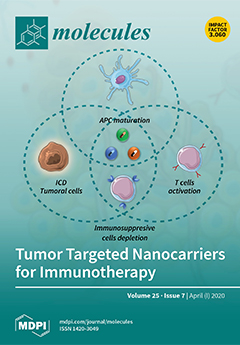Hepatocellular carcinoma (HCC) is considered to be a silent killer, and was the fourth leading global cause of cancer deaths in 2018. For now, sorafenib is the only approved drug for advanced HCC treatment. The introduction of additional chemopreventive agents and/or adjuvant therapies
[...] Read more.
Hepatocellular carcinoma (HCC) is considered to be a silent killer, and was the fourth leading global cause of cancer deaths in 2018. For now, sorafenib is the only approved drug for advanced HCC treatment. The introduction of additional chemopreventive agents and/or adjuvant therapies may be helpful for the treatment of HCC. After screening 3000 methanolic extracts from the Formosan plant extract bank,
Excoecaria formosana showed glycine
N-methyltransferase (GNMT)-promoter-enhancing and nuclear factor erythroid 2-related factor 2 (NRF2)-suppressing activities. Further, the investigation of the whole plant of
E. formosana led to the isolation of a new steroid, 7α-hydroperoxysitosterol-3-
O-β-
d-(6-
O-palmitoyl)glucopyranoside (
1); two new coumarinolignans, excoecoumarin A (
2) and excoecoumarin B (
3); a new diterpene, excoeterpenol A (
4); and 40 known compounds (
5–
44). Among them, Compounds
38 and
40–
44 at a 100 μM concentration showed a 2.97 ± 0.27-, 3.17 ± 1.03-, 2.73 ± 0.23-, 2.63 ± 0.14-, 6.57 ± 0.13-, and 2.62 ± 0.05-fold increase in GNMT promoter activity, respectively. In addition, Compounds
40 and
43 could reduce NRF2 activity, a transcription factor associated with drug resistance, in Huh7 cells with relative activity of 33.1 ± 0.2% and 45.2 ± 2.5%. These results provided the basis for the utilization of Taiwan agarwood for the development of anti-HCC agents.
Full article






